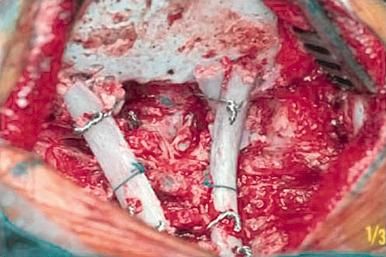Physical Address
304 North Cardinal St.
Dorchester Center, MA 02124
| Chapter Synopsis | The upper cervical spine encompasses the area spanning the occiput, the atlas (C1), the axis (C2), and the C2-C3 motion segment. The authors discuss four main approaches to the upper cervical spine: the dorsal or posterior, the posterolateral transcondylar, the transoral transpalatopharyngeal, and the transcervical extrapharyngeal. The indications for, applications of, and descriptions of each approach are reviewed. |
| Important Points | Selection of the appropriate approach, technique, and construct depends on the patient’s age, pathologic process, bony anatomy, and alignment. |
| Clinical and Surgical Pearls |
|
| Clinical and Surgical Pitfalls |
|
The upper cervical spine is defined by the area encompassing the occiput, the atlas (C1), the axis (C2), and the C2 to C3 motion segment. The anatomic complexity of this region is related to the uniqueness of the bony anatomy of each of these segments and the relation to neural and vascular structures. A comprehensive and detailed knowledge of this intriguing region is key not only to surgical management of the protean disorders affecting this area but also to avoidance of complications.
Selection of the appropriate approach, technique, and construct depends on the patient’s age, pathologic process, bony anatomy, and alignment ( Fig. 2-1 ).
The dorsal or posterior approach is the most common approach to the upper cervical spine. Through this exposure, atlantoaxial and occipitocervical decompression and fusions can be accomplished. The indication for atlantoaxial fusions is C1 and C2 instability, whereas the indications for occipitocervical fusion include occipitocervical instability and C1-C2 fusion failure. In adults, trauma, tumors, and rheumatoid arthritis are the primary causes of occipitocervical and atlantoaxial instability. In children, congenital abnormalities, Down syndrome, Klippel-Feil syndrome, and various causes of basilar invagination and impression lead to instabilities in this area. Bony components alone or in combination with ligamentous attachments (primarily the transverse and alar ligaments) can be affected by all these processes, with resulting instability.
Exposure is achieved through a midline incision from the inion to the C4 spinous process down to the deep cervical fascia. The occiput and the C2 spinous process are identified early during the dissection. Incising through the avascular ligamentum nuchae aids in keeping the dissection midline and avoids unnecessary muscle bleeding.
The points of insertion of suboccipital musculature are the posterior arch of C1, the spinous process, and the lamina of C2. These muscles are detached through subperiosteal dissection with monopolar electrocautery in a mediolateral direction. Dissection beyond 12 mm is transitioned to bipolar cutting current or dissection with a Freer elevator in a subperiosteal fashion, by staying ventral to the suboccipital fascia. This procedure should be done carefully because the vertebral artery courses around the lateral mass of C1 medially in the superior aspect of the posterior arch of C1. Another vascular structure of concern is the suboccipital venous plexus behind the occiput-C1 and C1-2 interspace.
Occipitocervical fusion can be semirigid or rigid. Semirigid fixation includes contoured loop and wire instrumentation. This procedure is supplemented with a postoperative halo vest or a molded rigid orthosis. Rigid fixation encompasses rod and screw fixation. Selection of the type of instrumentation is dictated by the patient’s age, disease process, and associated bony anatomy.
In young patients (3 to 6 years of age), semirigid fixations are employed to allow for additional growth and remodeling. Moreover, the small size of the spine and the incomplete ossification in these patients render rod and screw constructs infeasible. Intraoperative traction to improve and maintain alignment is critical. Thus, the authors most often use crown halo traction resting on a Mayfield headrest, rather than the Mayfield three-point pin headrest for positioning.
After awake intubation, the patient is positioned prone on the operating table. The head is placed in the cerebellar headrest. Attention should be paid to ensure that no pressure is placed on the eyes. Between 5 and 7 pounds of traction is maintained throughout the operation for satisfactory alignment of the craniocervical junction.
A lateral radiograph using a C-arm fluoroscope is obtained to confirm that appropriate occipitocervical alignment has been maintained.
Subperiosteal electrocautery is used to expose the occipital bone and the dorsal upper cervical spine in a subperiosteal fashion. A notch is placed inferiorly and superiorly on each lamina at its junction with the facet, and a hole is drilled through each side of the occipital bone lateral to the foramen magnum. Titanium cables are passed in a sublaminar fashion and from the occipital trephines to the foramen magnum, to gain occipital purchase. These cables have the advantage of being more pliable yet have equivalent strength compared with wire.
Autologous bone is harvested from the rib or iliac crest, with the former having the advantages of a lower complication rate, improved strength, and less donor site pain. The graft is notched adjacent to the lamina, and notch or a hole is placed in the rostral end for the occipital cable. The graft is then secured to the recipient laminar surface, or the occipital bone, or both, and the cables are tightened. Postoperatively, patients are immobilized in a custom-made occipitocervical brace for 5 to 6 months ( Fig. 2-2 ).

Become a Clinical Tree membership for Full access and enjoy Unlimited articles
If you are a member. Log in here